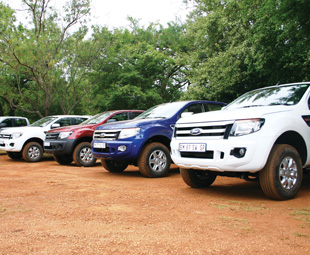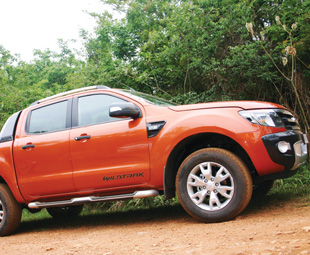A world of difference

Ford’s all-new Ranger is set to hit local showrooms any time now. It was designed to be a game changer, so GAVIN MYERS ventured into the beautiful scenery of Mpumalanga to put it through its paces.
There is a little problem that almost every manufacturer competing in South Africa’s double- and single-cab market faces. It is known as Hilux – rightly or wrongly a long-standing by-word for phrases like “undisputed market leader” and “king of the hill”. The Hilux, though, is slowly coming under some not-so-friendly fire from a variety of new and next-generation models in its segment. Up until now, perhaps, none more so than the VW Amarok …
I say “perhaps”, because Ford has just thrown a fly in the ointment with its all-new Ranger. This is a significant “truck” for Ford (which likes using that term to describe the model). It is the first such vehicle to be built on the One Ford principle – the company’s melting pot for the best in-house expertise from around the world – and the Blue Oval is confident that it’ll be a game-changer.
So let’s get it out in the open from the beginning: the all-new Ranger is extremely good in just about every regard. It really is the best that the company’s various global engineering centres of excellence have to offer in terms of creating an ideal “world product”.
The Ranger’s global design and engineering team was headquartered in Australia and the new vehicle is being built on three continents. Ford South Africa, though, will produce vehicles for export to 148 of the 180 individual markets at its Silverton assembly plant in Pretoria.
 Little wonder, then, that the model’s international media launch was held in the areas surrounding the picturesque Panorama Route in Mpumalanga, just a week before us local scribes got to sample it there, too. It was worth the wait.
Little wonder, then, that the model’s international media launch was held in the areas surrounding the picturesque Panorama Route in Mpumalanga, just a week before us local scribes got to sample it there, too. It was worth the wait.
On those magnificent roads, the Ranger impressed with its brilliant on-road dynamics. Even with an empty load-box, it remained quiet, comfortable, sure-footed and planted (this holds for off-road driving, too). Indeed, it rides and handles like a decent car, with part of the reason being the new ladder-frame chassis, which is twice as strong as its predecessors.
There is also a new power steering system in place that is perfectly weighted and transmits good feel from the large off-road tyres (up to 265/60R18). It also helps with the Ranger’s great manoeuvrability – despite its 5 274 mm long and 2 163 mm wide bulk, this is an easy vehicle to drive both on-road and off.
It is an extremely comfortable one, too. Ford went as far as to make the double-cab’s front doors 100 mm shorter than the single- and super-cabs in order to improve entry to the rear seats. Once seated, the larger body and wheelbase improve head, knee and shoulder room all round, and the seats themselves are comfortable and supportive. The cabin is stylish, modern and feels high quality. Of course, all the usual mod-cons are in place – the XLS, XLT and Wildtrak are all well spec’d.
The driving position is spot-on and all controls fall easily to hand. This was ideal when navigating the tricky off-road course Ford had lined-up at the launch. A flick of a switch to engage four-wheel drive, and the Ranger sailed through the course. Its Hill Decent Control automatically braked individual wheels to guide the vehicle down treacherous slopes, while the torquey engines had no problems with climbing them again.
 Also built in South Africa at Ford’s Struandale engine plant in Port Elizabeth, the 3,2 five-cylinder and 2,2 four-cylinder Duratorq TDCi engines bring new definition to diesel-powered bakkies. The 3,2-litre develops 147 kW at 3 000 r/min and a muscular 470 Nm between 1 500 and 2 750 r/min. This engine can be mated to a six-speed manual or – a first for this segment – a six-speed automatic transmission.
Also built in South Africa at Ford’s Struandale engine plant in Port Elizabeth, the 3,2 five-cylinder and 2,2 four-cylinder Duratorq TDCi engines bring new definition to diesel-powered bakkies. The 3,2-litre develops 147 kW at 3 000 r/min and a muscular 470 Nm between 1 500 and 2 750 r/min. This engine can be mated to a six-speed manual or – a first for this segment – a six-speed automatic transmission.
The 2,2-litre is available with two power outputs. These are either 110 kW at 3 700 r/min with 375 Nm between 1 500 and 2 500 r/min, or 88 kW at 3 700 r/min and 285 Nm between 1 500 and 2 300 r/min. The high-power 2,2-litre can be mated to either a five- or six-speed manual gearbox, while the mid-power is available with only the former. Ford claims combined fuel consumption figures between 7,6 and 9,2 l/100 km, depending on engine and drivetrain combination.
There is also a 2,5-litre four-cylinder Duratec petrol engine available, producing 122 kW at 6 000 r/min and 225 Nm at 4 500 r/min, although this was unavailable for sampling at launch. However, the diesel engines are as strong and flexible as their figures suggest and, although the manual gearboxes are very notchy, the new automatic is sublime.
Whatever the engine/gearbox combination, the Ranger should have no problem lugging around its intended load. GVM ranges from 2 925 kg to 3 200 kg, payload from 965 kg to 1 232 kg, while up to 750 kg (unbraked) and 3 350 kg (braked) can be towed.
The load box also features cross-supports and spot welds, as well as robust D-pillars, to stiffen the structure and brace against overloading. There are six external and six internal tie-down hooks, the internal hooks being rated at 500 kg each.
The load box follows the form of the body design, with its high beltline and bold wheel arches. In profile, the new Ranger does look sporty, while from the front it is confident, bold and aggressive. Even the rear, a traditional bakkie weak point, looks good. Ford says it wanted capable but stylish looks, combining the best of American boldness and European sophistication. Its worked; the Ranger is easily one of the best looking vehicles in its segment.
The all-new Ranger comes with a five-year/90 000 km Service Plan and four-year/120 000 km warranty. Ford also offers three-year Roadside Assistance and a five-year corrosion warranty. Pricing is on the steep side, ranging from R174 000 all the way up to R436 700. However, the Ranger has a lot of value to offer for the money, and this is where it takes the fight to the competition. Is there actually anything wrong with the new Ranger? Nope, save for the way buyers tend to flock to Hilux showrooms …
Published by
Focus on Transport
focusmagsa



